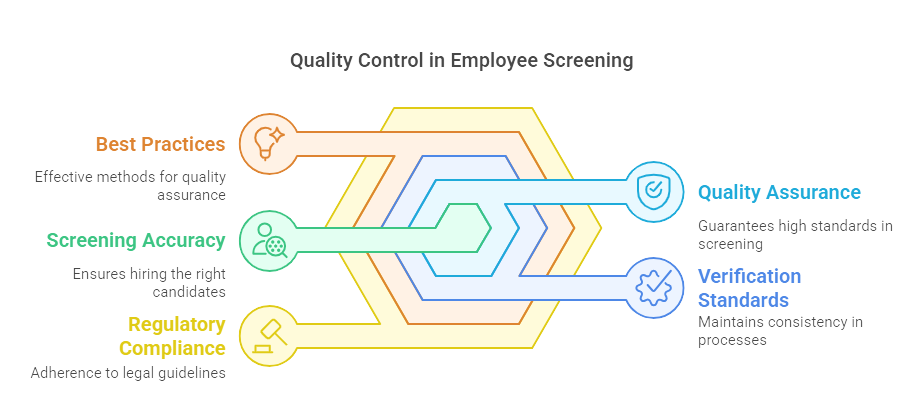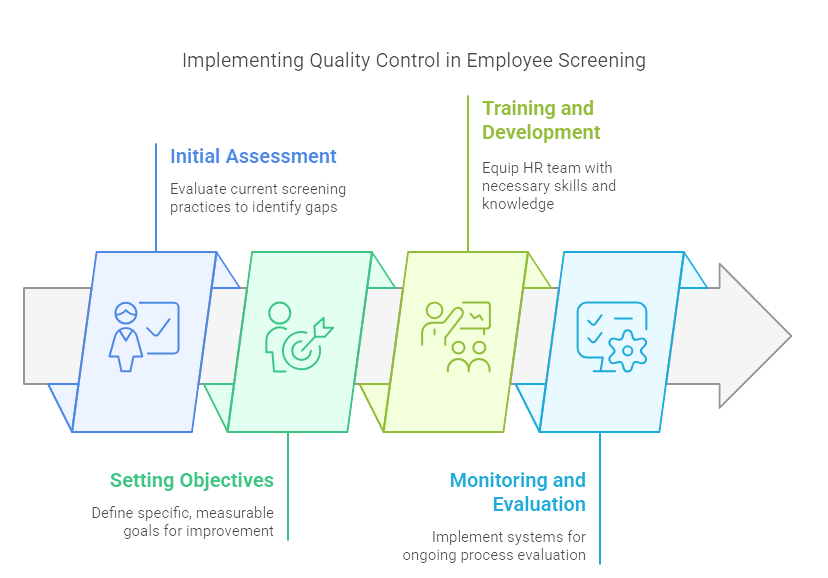In the competitive world of business, the importance of selecting the right candidates can't be overstated. Quality control in employee screening is essential for businesses to thrive, reduce turnover, and maintain a safe and productive workplace. This comprehensive guide is tailored for business owners, HR professionals, recruiters, and job seekers, providing insights into the best practices, standards, and technologies that ensure screening accuracy and reliability.
Key Takeaways
- Quality control in employee screening is essential for building a reliable, efficient, and fair hiring process.
- Robust screening practices mitigate risks, ensure compliance with labor laws, and enhance employee retention.
- Leveraging both internal resources like the GCheck Blog and external guidelines from the U.S. Department of Labor helps maintain high screening standards.
- Implementing advanced technologies and standardizing verification processes significantly improve accuracy and reliability in screening.
- Addressing challenges such as data inaccuracies and complying with evolving legal standards requires continuous training, audits, and the use of AI tools.
Introduction
In today's fast-paced business world, the importance of hiring the right people can't be overstated. Picking the right candidate isn't just about filling a position; it's about securing the future of your organization. Quality control in employee screening ensures you're not just getting a warm body but a valuable team member.
What does quality control mean in this context? It's about more than just checking boxes. It's the framework that ensures every screening step is carried out accurately and reliably. Whether it's verifying documents, cross-referencing information, or leveraging advanced technologies, maintaining high standards is non-negotiable.
In this guide, we'll unpack why quality control in employee screening is vital. We'll walk you through key practices, discuss verification standards, and introduce you to the role of evolving technologies. Stick with us, and you'll gain the insights needed to transform your screening process into a competitive advantage.

The Importance of Quality Control in Employee Screening
Quality control in employee screening is about vetting potential hires thoroughly and consistently, ensuring each candidate meets your company's standards. It's not just a box to tick; it's a fundamental aspect of modern HR practices that can make or break a business.
For employers, robust screening processes do more than filter out unqualified applicants. They play a vital role in mitigating risks—be it through uncovering falsified credentials or identifying past criminal behavior. Beyond this, effective screening helps ensure compliance with a myriad of labor and safety laws, reducing legal liabilities. But perhaps most importantly, it enhances employee retention. When you bring on board genuinely qualified individuals who share your company's values, they're more likely to stick around, reducing the pervasive issue of high turnover.
On the flip side, job seekers also benefit from stringent screening practices. Accurate and fair screening promotes a sense of trust in the hiring process. When candidates know they're being judged based on their true qualifications and abilities, it levels the playing field, eliminating biases that might otherwise cloud hiring decisions. Fairness in screening doesn't just benefit individual applicants; it builds a more robust, more diverse workforce that propels the business forward.
For those looking to delve deeper, resources like the GCheck Blog can provide additional insights on background checks and employee screening trends. For overarching federal guidelines that help frame these practices, the U.S. Department of Labor offers information on hiring standards and compliance.
Ensuring quality control in employee screening isn't just about fulfilling a procedural requirement—it's about building a reliable, efficient, and fair hiring process that serves both the employer and the job seeker.
EXPERT INSIGHT: Working in the field of human resources, I have seen that good recruitment is not by accident; it is based on careful and systematic screening. Quality assurance of employee screening process is not only performed to protect the company, but also to respect the people we welcome to our company. Correctly done, the process permits healthier workplaces, reduced turnover costs, and forms strong teams that promote our corporate values. I have seen firsthand that a systematic process not only develops one department, but affects overall organizational culture. With an increasingly fast-paced world, quality is what anchors our decision. - Charm Paz, CHRP
Key Components of Quality Control in Screening
Quality Assurance
Quality assurance in employee screening isn't just a box to tick; it's the backbone of hiring trustworthy, capable candidates. It guarantees that every step of the screening process meets high standards, beginning with the basics and extending to continuous refinement.
Best Practices: Effective quality assurance starts with training your HR team. Regular workshops or courses on the latest screening methods and legal requirements keep everyone on the same page. Standardized procedures are your next defense; consider them your playbook, ensuring every candidate undergoes the same thorough vetting.
Continuous Improvement: Quality assurance isn't static. Regular audits help identify weaknesses in your screening process, and feedback loops enable constant tweaking. Staying up-to-date with legal requirements and industry standards is crucial. If the regulatory landscape shifts, your procedures should, too, minimize risk and maximize compliance.
Verification Standards
Standardization in verification processes is the cornerstone of consistency in employee screening. Without it, you risk inconsistencies and errors that undermine trust and reliability.
Standardization: Clear, uniform procedures ensure that every candidate is subjected to the same level of scrutiny. This improves accuracy and fairness in the hiring process.
Documenting Procedures: Every step in your verification process should be documented meticulously. This includes how you conduct reference checks, employment verifications, and education verifications. Clear documentation helps train new team members and ensures everyone follows the same protocol.
Regulatory Compliance: Following guidelines set by bodies like The Professional Background Screening Association (PBSA) ensures you hit all the right notes in your verification processes. Compliance with local, state, and federal laws isn't just about avoiding fines but building a screening process beyond reproach.
Screening Accuracy
Accuracy in screening cuts straight to the heart of quality control. Inaccurate screenings can lead to hiring the wrong candidate or missing red flags in someone’s background.
Accuracy Metrics: To gauge the performance of your screening process, you need metrics like error rates and turnaround times. These metrics act as your dashboard indicators, revealing areas that need improvement and those that are functioning well.
Quality Control Mechanisms: Implementing double-checking protocols and cross-referencing information from multiple sources safeguards against mistakes. Even minor errors in background checks can lead to significant problems down the road.
Technology and Tools: Harnessing advanced technologies like AI and machine learning can revolutionize your screening process. These tools can analyze vast amounts of data quickly and accurately, flagging inconsistencies that human eyes might miss. This not only enhances accuracy but also speeds up the screening process.

Legal and Ethical Considerations
Ensuring compliance with legal and ethical standards in employee screening is non-negotiable. The legal framework surrounding employee screening is well-defined and multifaceted, and understanding these regulations helps prevent costly mistakes.
Legal Framework
First and foremost, the Fair Credit Reporting Act (FCRA) governs the use of consumer information by which most background checks are assessed. Employers must ensure they have explicit consent from candidates before obtaining any consumer report. Additionally, under the FCRA, candidates must be informed when adverse actions are taken based on the information in their background checks.
Beyond the FCRA, anti-discrimination laws such as those enforced by the Equal Employment Opportunity Commission (EEOC) play a critical role. Employers must ensure their screening processes do not disproportionately exclude certain groups of people unless the exclusions are job-related and consistent with business necessity. This involves adhering to guidelines on how to consider arrest and conviction records in employment decisions to avoid discriminatory practices.
Ethical Standards
Ethical responsibilities in employee screening are just as important as legal obligations. Employers must respect candidates' privacy and treat all information with confidentiality. Misuse or mishandling of personal data not only risks legal repercussions but also damages the trust and reputation of the organization.
Additionally, conducting unbiased screenings is paramount. This means applying the same evaluative criteria to all candidates to avoid any form of discrimination. Utilizing standardized checklists and criteria for screening helps promote consistency and fairness. It's essential to remember that ethical screening practices contribute to building a more inclusive and diverse workplace.
In conclusion, aligning screening practices with legal requirements and ethical standards not only ensures compliance but also fosters an environment of fairness and respect. By doing so, businesses not only safeguard themselves against potential liabilities but also enhance their reputation as fair and responsible employers.
Implementing Effective Quality Control Measures
Ensuring quality control in employee screening doesn't happen by accident; it requires a well-structured approach. Here's a straightforward guide to putting effective quality control measures into practice:
Initial Assessment
Start by evaluating your current screening practices. This baseline will help you identify gaps and inconsistencies. What are your current steps for background checks, and how do you verify information? Document the existing process meticulously.
Setting Objectives
Once you have a clear picture, set specific, measurable objectives. These could include reducing error rates, shortening turnaround times, or increasing compliance with legal standards. Objectives should be clear and attainable, setting the stage for targeted improvements.
Training and Development
Your HR team is your front line in employee screening. Ensure they are well-trained in both the legal aspects of screening and the technical skills required for thorough checks. Regular workshops and training sessions can keep everyone updated on best practices and technological advancements.
Monitoring and Evaluation
Finally, implement a robust system for ongoing monitoring and evaluation. This could involve routine audits, periodic reviews, and automated alerts for inconsistencies. Use data and feedback to fine-tune the process continuously. Monitoring tools and auditing mechanisms should be as automated as possible to minimize human error and ensure accuracy.
By following these steps, you’ll establish a reliable and effective quality control framework, resulting in a more competent and trustworthy workforce.

Challenges and Solutions
Common Challenges
Maintaining quality control in employee screening isn't without its hurdles. Data inaccuracies often top the list. Whether it's outdated databases or human errors during data entry, inaccurate information can derail the entire screening process. The rapid pace of hiring in today's competitive market adds another layer of difficulty. HR departments are often pressured to fill roles quickly, leading to shortcuts and oversight. Finally, the evolving legal landscape requires constant vigilance. Staying compliant while ensuring efficient screenings can be daunting.
Practical Solutions
Addressing these challenges requires a multi-faceted approach. Leveraging technology is a game-changer. Advanced AI and machine learning algorithms can sift through vast amounts of data quickly and accurately, reducing human error. Continuous training for HR personnel ensures they are up-to-date with the latest best practices and legal requirements. Lastly, third-party audits provide an impartial review of the screening processes, highlighting areas for improvement and ensuring compliance. Through these measures, businesses can tackle common challenges effectively, ensuring their screening processes remain robust and reliable.
Conclusion
Ensuring quality control in employee screening isn't just a checkbox on an HR to-do list—it's a foundational practice that can make or break a company’s success. This guide has emphasized the importance of every component, from setting high verification standards to leveraging cutting-edge technology for accuracy. The legal and ethical considerations underscore the responsibility employers must shoulder to maintain fairness and compliance.
While challenges like data inaccuracies and rapid hiring cycles are inevitable, solutions such as continuous training, advanced tools, and rigorous procedures offer viable pathways to improvement. Implementing these measures will not only safeguard against potential risks but also build a strong, reliable workforce that supports long-term growth.
The key takeaways should be clear: meticulous quality control in employee screening enhances trust, efficiency, and organizational integrity. For employers, it reduces turnover and mitigates risk. For job seekers, it ensures a fair and transparent hiring process. By prioritizing these practices, all stakeholders can look forward to a safer and more productive workplace.

